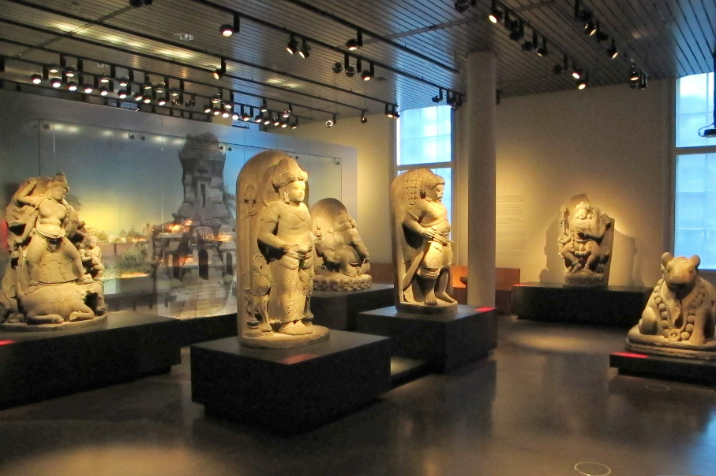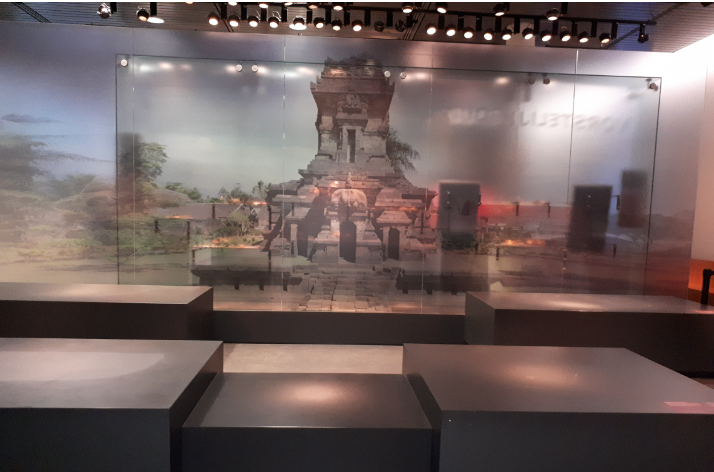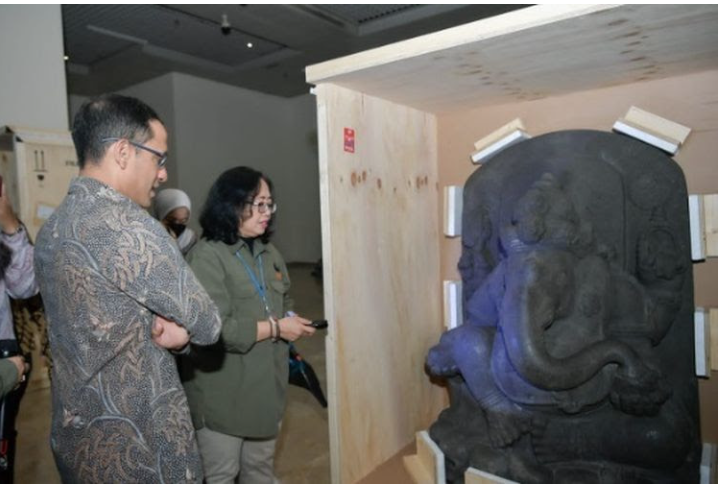By Dr Lesley Pullen, History of Art and Archaeology
SOAS, University of London, and AIS Council Member

In the first half of the nineteenth century, during the extended period of the Dutch administration of the Netherlands East Indies, a Dutch colonial official arranged for a group of six stone sculptures up to 1.7 metres high of Hindu Buddhist figures originating from the Singosari temple site in the northeast outskirts of present-day Malang, East Java, to be shipped to The Netherlands.
After a period during which they were moved around the country, these six sculptures have stood on public display in the Museum Volkenkunde in Leiden since 1903, and as recently as 2012, a new gallery was opened, custom-built to display them.

During the first week of August 2023, four of these six sculptures, the figures of Nandishvara, Mahakala, Durga and Ganesha, were removed from this relatively new gallery and packed, ready to be transported back to Java. The other two sculptures, the Nandi and Bhairava figures, remain in this gallery for the present but are also subject to a claim from Indonesia.
This repatriation is a direct result of the Netherlands government formally releasing on 7 October 2020 a comprehensive restitution report produced by the ‘Advisory Committee on the National Policy Framework for Colonial Collections’ (the Goncalves Committee), which resulted in the formation of their ‘Pilot Project Provenance Research on Objects of the Colonial Era’ initiative.
One outcome of this initiative was the simultaneous announcement on 10 July 2023 by both the Netherlands and Indonesian governments of the transfer of ownership and the repatriation of 472 objects of Indonesian origin, including these four Hindu Buddhist stone sculptures. In official Indonesian government announcements, there has been no mention that these four statues are of Hindu Buddhist origin, only that they were produced during the reign of the last king of the Singosari dynasty, King Kertanagara (1269-1292), whose kingdom was centered near Malang.
Dr Pieter ter Keurs, who, amongst other positions, is Professor of Museums, Collections and Society at Leiden University, commented on 11 July 2023 on the transfer of ownership of these four statues: “The committee was unable to find out who owned the statues, the temples were overgrown and were not kept by the locals. It is unknown whether he (the Dutch colonial official) negotiated with anyone about taking the images with him. The committee says it is plausible that the images were taken unlawfully, but there is no evidence for that. I am not against the return of these images, but I do not think the reasons given are strong.”
On each of the four plinths where these sculptures formally stood, the Museum Volkenkunde has placed a label with the following caption: “The statue on display here was officially handed over to the Republic of Indonesia on 10 July 2023.”

pullen.london@btinternet.com
With only two remaining sculptures, this purpose-built gallery now stands nearly empty and displays a board addressing the museum’s broader restitution policy, which concludes: “Restitution – the return of these objects – gives concrete form to the Netherlands’ acknowledgement of a long and painful history. Ongoing research, some of it conducted in collaboration with Indonesia, will focus on enhancing our understanding of the precise process of colonisation, and our knowledge of objects.”
Discussions continue within Indonesia regarding where the four repatriated Singosari statues will be housed. They were delivered to the Museum Nasional Indonesia, Jakarta, and their wooden crates opened on 22 August 2023 in the presence of Minister of Education, Culture, Research and Technology Nadiem Anwar Makarim. While it is natural to assume they will be placed on display at the Museum Nasional Indonesia in the first instance, no apparent secure internal display space is available. Then, after they have enjoyed some display time in Jakarta, the important question remains as to whether they will be returned to their place of origin.
